Liverpool's Historic Rail Tunnels
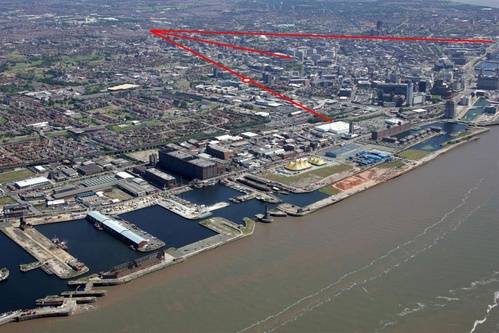 Victoria/Waterloo Tunnel to the left with Byrom Street Cutting - Lime Street Tunnel centre - Wapping Tunnel to the right. The Victoria/Waterloo and Wapping Tunnels are awaiting recommission.
Victoria/Waterloo Tunnel to the left with Byrom Street Cutting - Lime Street Tunnel centre - Wapping Tunnel to the right. The Victoria/Waterloo and Wapping Tunnels are awaiting recommission.
Liverpool was a pioneer in railways with the earliest examples of the world's first innovative rail infrastructure found in the city. There are spurious claims from around the world of first in rail tunnels. Americans claim the oldest tunnel under streets is the Atlantic Avenue tunnel of 1844, in New York - sealed up in 1861 it was forgotten until rediscovered in 1980. London claim the Brunel tunnel under the River Thames. The Liverpool tunnels pre-date any tunnel in New York or London.
A proposed scheme to reuse the disused tunnels: Extending Rapid Transit Merseyrail
Edge Hill Junction
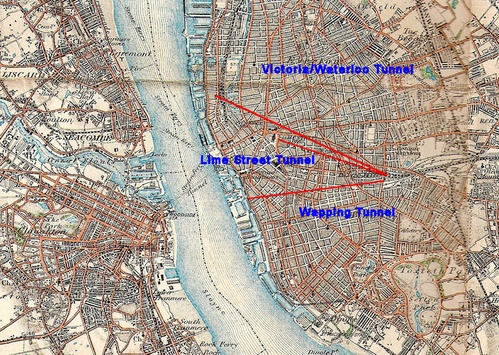 Edge Hill Junction and tunnels. Located east of of Liverpool's city centre, Edge Hill is situated at the top of an escarpment that rises from the River Mersey. The land flattens out at this point. In 1829, the Liverpool to Manchester passenger railway entered from Manchester in the east, with the passenger terminal located at Crown Street, Edge Hill. In order to transport goods to and from Liverpool docks, the 1.26 mile Wapping Tunnel was bored under Liverpool to the South End Docks. Seven years later in 1836, a 1.07 mile tunnel was bored from Edge Hill to Lime Street in Liverpool's city centre. Twelve years after the Lime Street tunnel was bored in 1848, the 2.07 mile Victoria/Waterloo Tunnel was bored under Liverpool's city centre to the north end docks. Edge Hill became a major junction, sidings and goods terminal. Three major tunnels fanned out west from Edge Hill.
Edge Hill Junction and tunnels. Located east of of Liverpool's city centre, Edge Hill is situated at the top of an escarpment that rises from the River Mersey. The land flattens out at this point. In 1829, the Liverpool to Manchester passenger railway entered from Manchester in the east, with the passenger terminal located at Crown Street, Edge Hill. In order to transport goods to and from Liverpool docks, the 1.26 mile Wapping Tunnel was bored under Liverpool to the South End Docks. Seven years later in 1836, a 1.07 mile tunnel was bored from Edge Hill to Lime Street in Liverpool's city centre. Twelve years after the Lime Street tunnel was bored in 1848, the 2.07 mile Victoria/Waterloo Tunnel was bored under Liverpool's city centre to the north end docks. Edge Hill became a major junction, sidings and goods terminal. Three major tunnels fanned out west from Edge Hill.
To access the Crown Street station site, just west of the Edge Hill junction, a deep long cutting was cut out of solid rock. The cutting is also known as the Cavendish Cutting. At the western end of this cutting two tunnels were bored. One short tunnel to Crown Street Station,known as the Crown Street Stephenson Tunnel, and the other the long 1.26 mile long Wapping Tunnel, running to the South End Docks.
Edge Hill Junction Map
-
Edge Hill Junction & Crown Street Freight Yard outlined in red.
-
In blue, the 1829 single track Stephenson Tunnel terminated at Crown Street.
-
The world's first passenger station was at the end of the 1829 tunnel.
-
In green, the Wapping tunnel to Kings Dock runs below the Crown Street station.
-
In blue, the 1846 two track tunnel for extra freight lines to Crown Street, is shorter than the 1829 tunnel.
-
The cutting is deep. The Moorish Arch was between Chatsworth Dr and the three tunnel heads in the cutting.
-
The Moorish Arch location was adjacent to the first Edge Hill station in the deep cutting.
-
The steam winding engines were in side rooms in the cutting near the Moorish arch.
-
The 50 yard long two track 1836 tunnel to Lime Street is in green at Edge Hill Station.
-
The open Lime Street cutting can be seen running away to the north west from the 1836 tunnel.
-
In green, the Waterloo Tunnel's portal is north of Edge Hill station. The tunnel terminates at Waterloo Dock.
Edge Hill Junction & Crown Street Freight Yard outlined in red.
In blue, the 1829 single track Stephenson Tunnel terminated at Crown Street.
The world's first passenger station was at the end of the 1829 tunnel.
In green, the Wapping tunnel to Kings Dock runs below the Crown Street station.
In blue, the 1846 two track tunnel for extra freight lines to Crown Street, is shorter than the 1829 tunnel.
The cutting is deep. The Moorish Arch was between Chatsworth Dr and the three tunnel heads in the cutting.
The Moorish Arch location was adjacent to the first Edge Hill station in the deep cutting.
The steam winding engines were in side rooms in the cutting near the Moorish arch.
The 50 yard long two track 1836 tunnel to Lime Street is in green at Edge Hill Station.
The open Lime Street cutting can be seen running away to the north west from the 1836 tunnel.
In green, the Waterloo Tunnel's portal is north of Edge Hill station. The tunnel terminates at Waterloo Dock.
Crown Street Stephenson Tunnel - 1829
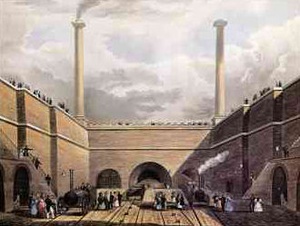 Edge Hill Cutting and Edge Hill Station,1830
Edge Hill Cutting and Edge Hill Station,1830  Edge Hill cutting - 291 yards Crown Street Stephenson tunnel right, 1.26 mile Wapping Tunnel in the middle. To the left the short 1846 Crown Street tunnel Running to Crown Street Station, 1829. Built by George Stephenson, a single track tunnel 291 yards long was bored from the deep cutting at the Edge Hill junction to Crown Street, to serve the world's first passenger railway station. However the tunnel is:
Edge Hill cutting - 291 yards Crown Street Stephenson tunnel right, 1.26 mile Wapping Tunnel in the middle. To the left the short 1846 Crown Street tunnel Running to Crown Street Station, 1829. Built by George Stephenson, a single track tunnel 291 yards long was bored from the deep cutting at the Edge Hill junction to Crown Street, to serve the world's first passenger railway station. However the tunnel is:  The dilapidated state of the Cutting today. The left 1846 tunnel is used for parking trains. The others tunnels are disused.
The dilapidated state of the Cutting today. The left 1846 tunnel is used for parking trains. The others tunnels are disused. 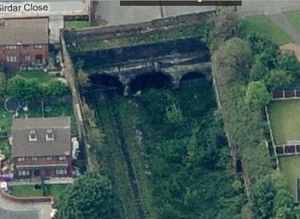 The dilapidated state of the Cutting from the air. Looking from the east
The dilapidated state of the Cutting from the air. Looking from the east 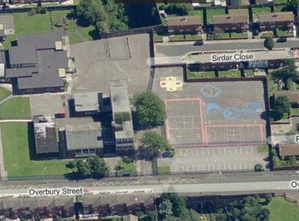 The 1846 Tunnel at the bottom - looking from the west. The cutting is at the top.
The 1846 Tunnel at the bottom - looking from the west. The cutting is at the top.
The oldest rail tunnel in the world running under streets.
The second oldest rail tunnel in the world after the very short 1804 tunnel at Pentrebach, Merthyr Tydfil.
Being too far from Liverpool city centre, the passenger station was abandoned in 1836 in favour of Lime Street. The area was converted for freight use.
An additional two track tunnel was bored through to Crown Street from the Edge Hill cutting in 1846, to increase traffic to the freight yard. The head of this tunnel was initially cut to about 3 metres deep in 1829 and used as a store room. The freight yard was closed in 1972 along with the original 1829 Stephenson tunnel. The Crown Street portal is landscaped over showing no trace of the tunnel at Crown Street apart from an incline of grass near the tall brick Wapping tunnel ventilation shaft, which was initially in the passenger station and then freight yard.
The historic 1929 Crown Street Tunnel is partially collapsing at the Crown Street end, due to lack of maintenance, as the subsidence in the street surface above indicates.
Wapping Tunnel - 1829
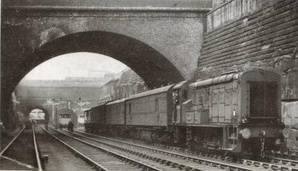 A diesel train emerging from the Wapping Tunnel at Edge Hill Cutting.
A diesel train emerging from the Wapping Tunnel at Edge Hill Cutting.  Park Lane Goods Station looking towards Wapping Tunnel
Park Lane Goods Station looking towards Wapping Tunnel 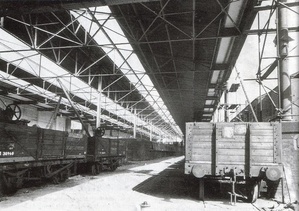 Park Lane Good Station after a re-build due to Luftwaffe bombing in 1940 The 1.26 mile (2.03 km) 1829 Wapping Tunnel is the first rail tunnel in the world bored under a metropolis. Currently disused since 1972 it is the second oldest tunnel under streets in the world, the first being the adjacent single track Crown Street tunnel. Having two tracks, the tunnel runs from Edge Hill junction in the east of the city to the south end Liverpool docks being used only for freight.
Park Lane Good Station after a re-build due to Luftwaffe bombing in 1940 The 1.26 mile (2.03 km) 1829 Wapping Tunnel is the first rail tunnel in the world bored under a metropolis. Currently disused since 1972 it is the second oldest tunnel under streets in the world, the first being the adjacent single track Crown Street tunnel. Having two tracks, the tunnel runs from Edge Hill junction in the east of the city to the south end Liverpool docks being used only for freight.
The termination point was Park Lane Good Depot near Kings Dock. Warehouses were directly over the rail lines with trap doors directly accessing the wagons below. The Goods Depot was heavily bombed by the German Luftwaffe in 1940 being rebuilt in the 1950s. The Wapping Tunnel terminated at Liverpool Docks in a wide open cutting, which was also a sand run-off trap for run-away rail wagons. The cutting had three very short tunnels under Park Lane and Jamaica Street into the Park Lane Goods Depot.
The tunnel is still in excellent condition and has been considered for reuse by Merseyrail rapid transit rail system. Suggestions in the past were for an underground station cut into the tunnel. The river portal is opposite the new Liverpool Arena at Kings Dock, being ideal for a serving station. If reused it will be the oldest used underground rail tunnel in the world and oldest part of any underground metro system.
The 1831 Liverpool-Manchester Railway Report. The tunnels are mentioned from page 146. http://tinyurl.com/Liverpool-Mcr-Railway-Report
Lime Street Tunnel - 1836
1836, Lime Street Station tunnel. A two track rail tunnel, 1.13 miles (1,811 metres) long was bored under a metropolis from Edge Hill junction in the east of the city to Lime Street. A new Edge Hill station was build at the western end replacing the station at the head of the Wapping Tunnel at Edge Hill. At the eastern end was Lime Street Station. In the 1880s the tunnel was converted to a deep open cutting four tracks wide. The only occurrence of a tunnel being removed at that point. A very short 50 metre section of the original tunnel still exists at Edge Hill giving the oldest tunnel in the world still in use and the oldest under streets, albeit now only under two streets.
 Edge Hill Station looking towards Lime Street. The open cutting can be seen beyond the short tunnel.
Edge Hill Station looking towards Lime Street. The open cutting can be seen beyond the short tunnel. 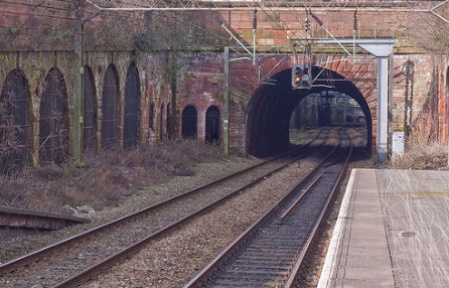 The remaining 50 yard section of the original 1836 tunnel at the end of the platform. The oldest Used Rail Tunnel in the World. Edge Hill station looking towards Lime Street. The short tunnel at the end of the platforms is a part of the original 1836 tunnel being 50 yards long. It runs under Tunnel Rd and the building above. The original two track tunnel at the end of the platforms was retained and short single track tunnels bored either side of the station increasing capacity to Lime Street to four tracks, giving two island platforms with a track each side. This increased capacity to four tracks. This approach meant the Edge Hill station required no rebuilt and the two platforms were converted to island platform The 1836 tunnel is still used making it the oldest used tunnel in the world and the oldest under streets.
The remaining 50 yard section of the original 1836 tunnel at the end of the platform. The oldest Used Rail Tunnel in the World. Edge Hill station looking towards Lime Street. The short tunnel at the end of the platforms is a part of the original 1836 tunnel being 50 yards long. It runs under Tunnel Rd and the building above. The original two track tunnel at the end of the platforms was retained and short single track tunnels bored either side of the station increasing capacity to Lime Street to four tracks, giving two island platforms with a track each side. This increased capacity to four tracks. This approach meant the Edge Hill station required no rebuilt and the two platforms were converted to island platform The 1836 tunnel is still used making it the oldest used tunnel in the world and the oldest under streets.
The sandstone buildings in the station are original containing offices and engine winding houses to haul trains up from Lime Street. The original 1830 Edge Hill station was further to the south in the Edge Hill cutting on the line running to Crown Street station, being moved onto the Lime Street line when operational.
Victoria/Waterloo Tunnel - 1848
 The Victoria Tunnel at Edge Hill - the large portal to the right
The Victoria Tunnel at Edge Hill - the large portal to the right
 The western end of the Waterloo Tunnel at Great Howard Street - Looking East.
The western end of the Waterloo Tunnel at Great Howard Street - Looking East.
This is one tunnel that changes its name along its run, however the whole tunnel is generally known as the Waterloo tunnel. An open cutting is the linking point of the two tunnels. The Victoria tunnel runs from Edge Hill in the east to the Byrom Street Cutting. The Waterloo tunnel runs from the Byrom Street Cutting to the Waterloo Goods Station in the west at Waterloo Dock.
Bored under a metropolis, the 2.07 miles (3.34 km) Victoria/Waterloo Tunnel opened in 1848. Initially used only for rail freight. Passengers and freight operated in the tunnel from 1895. From 1895 the termination point of the line at the western end was the Riverside Station at the ship liner terminal at the Pier Head. The Waterloo Goods Station ceased operation in 1964.
Used until 1972 the tunnel is still in excellent condition, being considered for reuse by the Merseyrail rapid transit rail system. Stations being cut into the tunnel are being considered at the Royal Liverpool Hospital. Reuse by a monorail system from the proposed Liverpool Waters redevelopment of Liverpool's Central Docks has been proposed.
From Edge Hill in the east the tunnel is on a steep incline down to the north end Liverpool Docks. The tunnel contains a series of ventilation shafts which were used to remove the spoil when under construction. The Victoria Tunnel runs from Edge Hill to a large open cutting at Byrom St. From Byrom Street the tunnel then continues to the Waterloo Goods Depot changing its name to the Waterloo Tunnel.
The picture to the right. The tunnel to the right is the disused 1848 Victoria tunnel. The Edge Hill portal is near the junction of Tunnel Road and Wavertree Road. The lines run into the tunnel for about a hundred metres for shunting purposes. The red sandstone above the tunnel is blackened by the smoke from trains.
The tunnel to the left at the Edge Hill portal is the additional 1880s single track tunnel for Lime Street that runs for 50 yards into the cutting beyond, forming four lines running into Lime Street. It is still used as the overhead wires indicate. There is an additional single track tunnel the other side of the original two track 1836 tunnel to widen out to four tracks. The original 1836 tunnel is the centre of the station beyond the Merseyrail sign.
Byrom Street Cutting
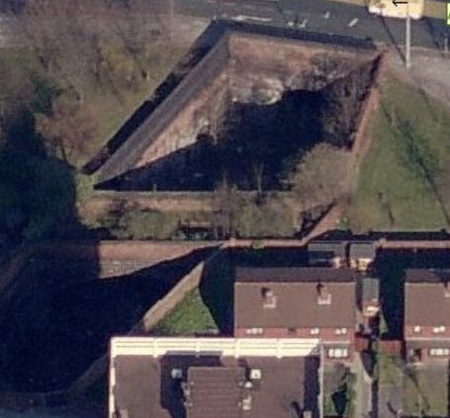 The Disused Byrom Street Cutting. Byrom Street is to the top of the picture. The Victoria Tunnel portal to Edge Hill can be seen.
The Disused Byrom Street Cutting. Byrom Street is to the top of the picture. The Victoria Tunnel portal to Edge Hill can be seen.
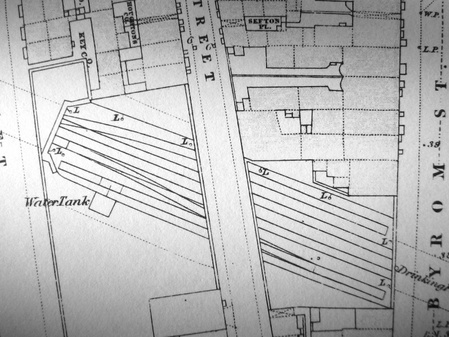 The Byrom Street Cutting in 1864, showing the sidings. Edge Hill is to the right, Waterloo Goods Station is to the left. The street running over the cutting is Hodson Street
The Byrom Street Cutting in 1864, showing the sidings. Edge Hill is to the right, Waterloo Goods Station is to the left. The street running over the cutting is Hodson Street
The Byrom St cutting contained sidings expanding from 2 tracks to 4 tracks in the cutting. The cutting was gas lit for 24 hour operation. Both tunnels incline down from the portals at Edge Hill and Waterloo Dock, although the incline from Waterloo Goods Station is quite shallow. The cutting is near to the lowest point of the two tunnels. Trains were cable hauled from the Byrom Street cutting to Edge Hill using a winding-engine at Edge Hill, as locomotives were not powerful enough to haul long heavy trains up the sharp incline to Edge Hill.
The cutting was a cable hitching and unhitching point for trains and a coaling and water point for shunting locomotives. Trains moved by gravity from Edge Hill to the Byrom Street cutting. Trains were shunted by locomotives to and from the Waterloo Goods Station and the Byrom Street Cutting. In 1895 cable hauling moved over to full locomotive haulage from the Waterloo Goods Station to Edge Hill. Byrom Street cutting changed its function to a runaway trap for runaway trains in the tunnel.
River Mersey Rail Tunnel - 1886
Designed by Charles Fox, the Mersey Railway tunnel opened in 1886 operating services between Liverpool and Birkenhead under the River Mersey. By 1892 the extensions on land from Birkenhead Park station to Liverpool Central Station Low level gave a tunnel 3.12 miles (5029 m) in length. The under river section is 0.75 miles in length, being the longest underwater tunnel in the world in 1886. The tunnel was a part of the Mersey Railway which was the second oldest underground urban railway network in the world. The Mersey Railway is now in integrated part of Merseyrail.
Construction of the Mersey Railway Tunnel
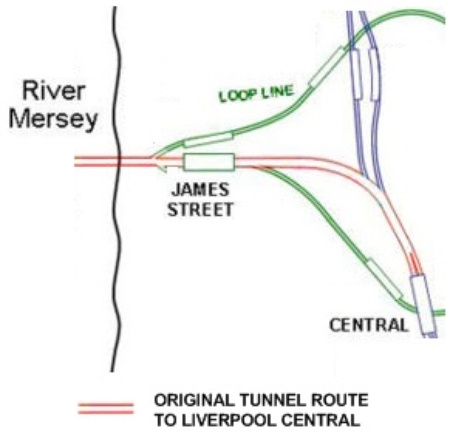 The red line is the original tunnel. The green and blue lines are the 1970s additions. Between the river and James Street Station the branch tunnels for Huskisson Dock were started and abandoned. One branch was later used in the 1970s.
The red line is the original tunnel. The green and blue lines are the 1970s additions. Between the river and James Street Station the branch tunnels for Huskisson Dock were started and abandoned. One branch was later used in the 1970s.
In December 1879, tunnelling work started. The initial tunnelling failed with work recommencing in 1880. Three tunnels were built. The main twin track rail tunnel is 26 foot wide and 19 foot high. The tunnel lining was 6 to 8 layers of brick. The other two smaller tunnels were for drainage and ventilation. After initially using explosives and hand tools, in 1883 a new boring machine, the compressed air driven Beaumont Cutter, was introduced. Progress improved rapidly. Telephone lines were laid through the tunnel between Liverpool and Birkenhead improving communications. In 1886 the tunnel was opened.
In 1886, a tunnel was planned to branch from the under-river tunnel from the river side of James Street Station to Huskisson Dock. This would carry mainly freight from the Wirral side of the river. The tunnel was never built, however the branch tunnel headers were built to a very short length. One of the branches was later used for the Wirral Line Loop tunnel through Liverpool city centre in the 1970s.
Because of smoke from the steam engines making breathing difficult in the tunnels and underground stations, the tracks in the tunnel were electrified in 1903 initially using 4th rail converting later to 3rd rail.
Drainage of the Tunnel
Large drainage pumps were built above ground at each end of the main vertical shafts on either side of the River Mersey. The base of the main shafts, very large standage headings were built capable of holding 80,000 gallons of water. This was to allow quick evacuation in case of tunnel flooding. Water would flow into the standage points.
Stations
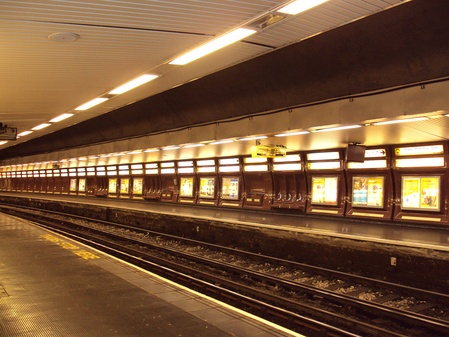 Hamilton Square underground station in Birkenhead, opened in 1886
Hamilton Square underground station in Birkenhead, opened in 1886
Stations were built at Hamilton Square in Birkenhead and James Street in Liverpool. These underground stations were the world's first to be cut out of solid rock, rather than the cut & cover method. Gas lights were used to light the stations and tunnel, ironically the men boring the tunnel used electric lighting. The stations were fitted with large hydraulic lifts operated by tall water towers.
January 1888 saw a branch line tunnel opening from Hamilton Square station to the new Birkenhead Park Station. In January 1892 the tunnel on the Liverpool side of the River Mersey was extended from James Street to a new underground station at Central Station. This section of tunnel needed supporting using iron girders.
Tunnel Used For Modern Eco Applications
The now named Capital Buildings, near the river front, was eco before it was fashionable, in 1973. The building has minimal glass to conserve heat. Interesting aspects is that the building uses water that seeps into the under river Mersey Railway tunnel. This water is pumped out of the tunnel being a near constant 12C - water seeps through the riverbed rock and is heated by the earth before it reaches the tunnel. This near constant temperature water is used to heat and cool the building. After use, the water is discharged into nearby storm drains, helping to keep them flushed and preventing an odour problem.
In winter the building is heated for a few hours on Monday morning and for the rest of the week the heat from people and office machines is usually enough to keep the building warm. At times it requires cooling in winter. In summer the 12C water may be enough to keep the building cool. The quantity of water pumped from the tunnel was more than required for the building, some of the water was sold to an adjacent insurance building under development at that time.
The original Victorian builders of the Mersey Rail Tunnel could never have envisaged that their tunnel would contribute to heating and cooling a building, assisting in keeping the air clean.
Dingle Tunnel
To come
Kirkdale to Rice Lane Tunnel
To come
Links
Extending Rapid Transit Merseyrail Merseyrail
Work ongoing - John



